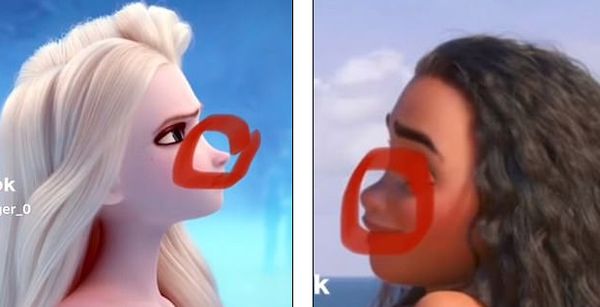
On TikTok, a former Disney fan raised an important issue about the portrayal of female characters in Disney movies. The video, posted by content creator Gangbanger_O, has gone viral with an astounding 5.3 million views and counting. It sheds light on the unrealistic depiction of little girls’ bodies through the noses of Disney princesses compared to the more realistic and defined noses of the villains.
The TikTok video showcases images of famous Disney princesses like Ariel, Moana, Elsa, Belle, Aurora, and Snow White, all of whom have tiny, upturned noses that don’t reflect reality. Conversely, the video contrasts these princesses with the villains, such as Jafar, Maleficent, Ursula, Clayton, and Mother Gothel, who have larger, more defined noses.

Accompanied by the song “Remember You” by Adventure Time, the video sends a powerful message: “Marceline, is it just you and me in the wreckage of the world? That must be so confusing for a little girl.”
Another video, created by Robin Reaction, also sheds light on the issue and has exceeded 5.1 million views. TikTok, known for its ability to captivate millions of viewers, has ignited a conversation around this topic.
The content creator in Robin Reaction’s video asks a crucial question, “How much nose is a Disney princess allowed to have?” They then explain that throughout the years, the princesses’ noses have always been minimalistic. The video points out that the depiction of evil female characters differs significantly, as they have more realistic-shaped noses.

“This lack of noses continued all the way through the ’80s, ’90s, and 2000s, and when non-white princesses started to be introduced, they received the same treatment,” the video explains. It showcases images of non-white princesses like Pocahontas, Mulan, and Tiana, highlighting the consistent pattern.
As the video continues, it emphasizes that when Disney transitioned to 3D animation, the characters had to have noses that took up as little space as possible. However, this constraint doesn’t apply to male characters who often have more realistic noses. It raises the important point that young girls might form unrealistic expectations about their bodies based on these depictions.

Disney fans are rightfully upset about the consistent portrayal of princesses with small noses, while villains are given more realistic features. This perpetuates a limited definition of beauty for women. It’s crucial for the entertainment industry to promote diverse and realistic representations so that young girls can grow up with a healthy and positive body image.





